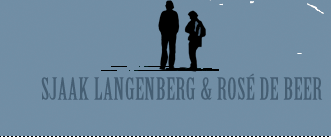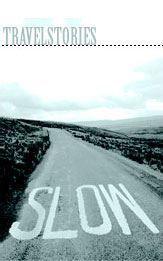




Desperate for a pee, Sjaak Langenberg and Rosé de Beer find themselves down a side road somewhere in Normandy. As he’s peeing against a tree, they discover an information sign showing a watercolour by Eugène Delacroix.
This completely randomly picked piss-stop turns out to be hanging in the Louvre. So, are there any places left that have never been written about, villages that aren’t in the guide books?
In his forthcoming book which has the working title Wildplassen met Delacroix (Taking a leak with Delacroix) Sjaak Langenberg investigates how one can relate to one’s predecessors now that even the back of beyond has been provided with several layers deep of meaning and Google is making a brain scan of our planet every millisecond. Each object, every place, each and every person has been captured in the thousands of interpretations of objects, places and people that exist. Everything has snowballed, each and every idea is immediately estranged from its origin.
‘Through Monet we see the sea for the first time in all her facets,’ claimed a critic in his time.
Nowadays, liberating things from their interpretation seems to be the motto.

 |
 |
 |
Although Seville flaunts her parks like a peacock flaunts his most beautiful feathers, Parque Sandeman in Jerez de la Frontera had no trouble in ousting all my memories of those sumptuous havens in the hectic capital of Southern Spain which I’d visited not so long before. Parque Sandeman is a fairly trifling little park that in ten years time will probably still look as though it’s just been erected. It’s bare, the benches are uncomfortable, when the wind blows, there’s nowhere that’s sheltered and the view across the suburbs of Jerez is enough to take your breath away. A man lets his dog out. Two boys are throwing the oranges fallen from the trees at a couple on a bench, in order to disturb their romantic rendezvous.
The park is situated opposite the entrance to Sandeman’s Sherry Bodega where 26 million litres of sherry are stored away. George Sandeman, a Scot, imported sherry to London from Jerez at the end of the eighteenth century. In October 1928 the image of ‘Zorro’ (Spanish sombrero, Portuguese cape) was printed on the labels of a sherry bottle for the first time - in an impossible pose in which with hunched shoulders, he appears about to imbibe a glass of sherry through his right ear. Nowadays there’s also an actual Zorro Lane a few streets away.
The bodegas in Jerez determine to a large extent the scene on the streets, as the sherry is stored smack in the middle of town. It exudes a sweet smell that remains perceptible far beyond the storage cellars. As if the warmth isn’t stupefying enough. When you go to the local tourist information office a helpful lady will calculate for you how best to see the sights of the city in a day. Arrival and departure times at the diverse sites are strictly dictated - if you need to pee, do it in your pants. You just have to hope that she’s not looking when you pass the window of the office later on at the wrong time of day. The tourist office emphatically advises you not to visit Parque Sandeman. That’s like a red flag to a bull. You just have to go there - the magic of a total lack of allure. In the seventies, advertisements encouraged clandestine drinkers to share their secret with the Sandeman. There is nothing secret about this park, but the Generalife in Granada pales in comparison to this place where ‘screening shrubs’ (trade term for park greenery that’s used to hide the ugly parts of buildings) are ‘given space’ as sculptures needing to be nurture. Irresistible, even for teetotallers.
© Sjaak Langenberg, 2014. All rights reserved. This text is intended solely for personal use. No part of this publication may be reproduced or displayed without prior written permission from the author.

